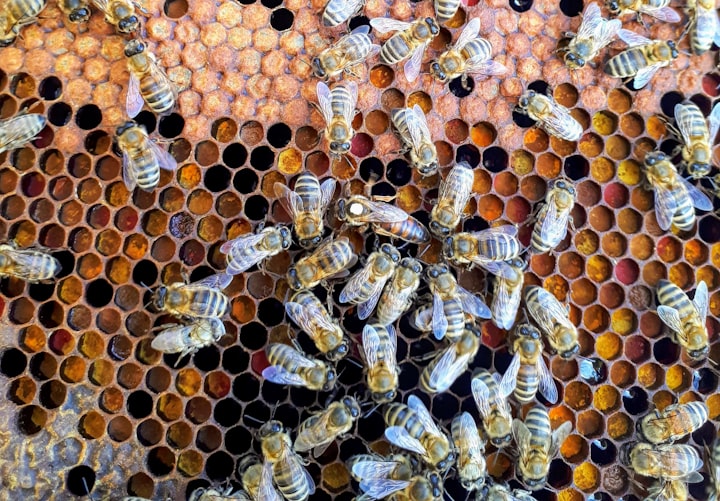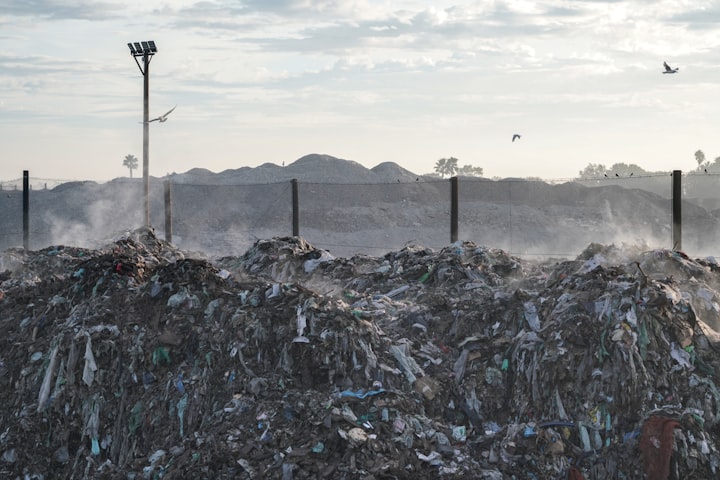What is Killing our Bees?
Bee populations are facing a perfect storm of disease, destruction and death. With bees responsible for pollinating most of our major food crops, this could spell disaster for global food security.

Listen to this article on Apple Podcasts or Spotify.
In the autumn of 2006, a strange phenomenon occurred on farms throughout the US. Beekeepers across the country emerged to check on their hives in preparation for the coming winter. They expected to find bustling insect metropolises humming with the activity of thousands of industrious worker bees storing food for the winter ahead. But the worker bees were gone.
In many cases, between 20,000 and 80,000 worker bees per hive had vanished overnight. The queen and her brood were often still there, and all the food the workers had stored was typically intact. The only sign of the departed workers was often just a few dead bees scattered at the entrance to the hive.
That year many US beekeepers reported losing between 50 and 90 per cent of their colonies. Similar losses were reported in Canada, Portugal, Italy, Spain, Greece, Germany, Poland, France and Switzerland.
We know now that this was the first appearance of Colony Collapse Disorder (CCD) — and it sparked a global effort to monitor and understand bee colony loss. Entomologists went to work measuring colony numbers in subsequent years. They found that between 2006 and 2011, average colony loss in the US was around 33 per cent. That’s more than double the 15 per cent winter loss rate that is considered normal.
The exact cause of CCD is disputed, but many entomologists believe multiple factors contribute to it. Varroa destructor mite infestations, along with a range of other fungal, bacterial and viral diseases are thought to play a role. Pesticide toxicity and bee malnutrition may also weaken hives, which makes them more susceptible to pathogens and parasites. But more on that later.
It’s not just commercial bees that are in trouble. Wild native bee populations are also declining around the world. One in four wild bee species in the US is at risk of extinction, and Australia’s ‘black summer’ bushfires in 2019-2020 have pushed 11 species of native bees onto threatened species lists.
The future for commercial bees began to look a little brighter when average colony loss rates recovered to around 24 per cent between 2014 and 2017. Then things suddenly got worse. Much worse. Between 2017 and 2018, colony loss in the US shot up to 40 per cent.
That number jumped again to 45.5 per cent between 2020 and 2021. This is more than 30 per cent higher than the 15 per cent loss rate that is accepted as normal. It has been called the ‘insect apocalypse’, and it’s very bad news for global food production.

Why are bees so important?
Bees are vital for our survival. Without healthy, sustainable bee populations we would face serious global food shortages that could severely threaten our food security.
That’s because commercial and wild bees are responsible for about 80 per cent of all global pollination, including 70 out of the top 100 human food crops. Greenpeace says that accounts for about 90 per cent of the world’s nutrition.
The implications bee health has for global food security are deep. Take California almond crops, for example. Californian almond orchards are responsible for about 80 per cent of the world’s annual almond supply. And those almond orchards depend on bees for annual pollination.
Let’s do the numbers on that. About 1.7 million bee hives — or around 80 billion bees — are needed to pollinate California’s 1.3 million acres of almond orchards. That equates to approximately 80 to 90 per cent of all commercial bees available in the US.
So every year bee hives are trucked across the country to Californian almond orchards for what has been called the largest managed pollination event in the world. It can cost almond farmers up to around $200 per hive to get the job done — and that cost rises as bee populations dwindle. It’s a simple case of supply and demand. Fewer bees means less pollination and a lower supply of almonds, which drives the price of almonds up for consumers.
That’s why just a small increase in annual colony loss in the US makes the almonds available in your supermarket significantly more expensive. And a large increase in annual colony loss means you can wave goodbye to almonds altogether. Apply that example to the 70 other top human food crops that also rely on commercial and wild bee pollination and you’ll start to feel the weight of the problem.
It’s not only humans who rely on bees. Declining native bee populations will have a significant impact on wild ecosystems. Native bees pollinate many of the nuts, seeds, berries and fruits that sustain wild animal populations. They also pollinate floral growth that creates habitat for birds and other insects.
Declining pollination means less abundant wild food sources and habitat for animals. That will have wide ranging effects on many different species, and could severely weaken complex and fragile ecosystems that are already struggling under the impacts of urban development, commercial agriculture, mining and climate change.
If bee colonies fall apart, so does human food production and many wild ecosystems. That holds dire implications for life on this planet.

What is killing the bees?
That’s a controversial question with a complex answer. Multiple factors are thought to play a role in CCD, and it’s important to note that CCD isn’t the only cause of colony loss.
The varroa destructor mite is the number-one culprit at play in CCD. The parasitic mite invades beehives, feeds on the bees and spreads deadly viruses, including the Deformed Wing Virus (DWV) that is closely associated with CCD.
But varroa mite infestations are not a new phenomenon. The first major wave of varroa infestation is thought to have occurred in Japan in the early 1900s, and has since spread to all inhabited continents except Australia. Researchers say even Australia is unlikely to escape the varroa mite for much longer.
So if the varroa mite has been doing its thing for more than 200 years, there must be other contributing factors driving the steep increase in modern-day colony loss. This is the controversial part of the story.
Agricultural pesticides — particularly neonicotinoids — have been found to kill bees on contact. Even trace exposure to neonicotinoids has been found to reduce bees’ ability to navigate, forage and reproduce.
Unsurprisingly, this is contested by the billion-dollar companies that make the pesticides. Industry associations such as the American Farm Bureau Federation (AFBF) also continue to support the responsible use of pesticides and oppose a ban on neonicotinoids.
That’s despite mounting evidence that points to the harmful effects of neonicotinoids on bee populations. A peer-reviewed 2019 research paper found that the agricultural use of insecticides in the US has “fundamentally shifted over the last two decades … to a mix dominated by neonicotinoids and pyrethroids.” The researchers concluded that neonicotinoids are “considerably more toxic to insects and generally persist longer in the environment.” They also found that neonicotinoids accounted for almost 92 per cent of total Acute Insecticide Toxicity Loading (AITL) from 1992 to 2014.
Environmentalists have been campaigning for a ban on neonicotinoids for years, but action has been slow. The European Union banned the use of three neonicotinoids in 2018, however has since issued at least 67 emergency authorisations allowing the use of neonicotinoids in 11 countries. In the US, the Environmental Protection Agency (EPA) canceled 12 neonicotinoid-based pesticides in 2019, but farmers continue to have access to other neonicotinoid-based products.
But there’s more to the issue than banning a few pesticides. Abundant grasslands that once sustained thriving bee populations have been cleared for giant monoculture farming operations. Like humans, bees need a diverse diet to thrive. Exclusively growing hundreds of acres of corn, wheat, soy or any other single commercial crop have severely reduced plant diversity for pollinators.
City areas are also not without fault. Fields, grasslands and forests surrounding our rapidly expanding cities are making way for sprawling residential and commercial developments that encroach on surrounding land. This is also decimating bee habitats and creating pollinator deserts in and around our major cities where natural environments once thrived.
This combination of pesticide use, monoculture agriculture and urban development has created a perfect storm for bees. All three factors are thought to be weakening bees’ immune systems and leading to bee malnutrition that leaves hives more vulnerable to varroa mite and other parasitic infestations associated with CCD.
It looks like climate change is playing a role too. A 2020 study found that an increasing frequency of unusually hot days across North America and Europe is “increasing local extinction rates, reducing colonisation and site occupancy, and decreasing species richness.”
This is a dangerous formula that is actively working against our own food security.

What does the future look like for bees?
The challenges facing bees are significant, but they are not insurmountable. Regenerative agriculture, permaculture and polyculture farming models are built around pesticide-free growing practices. They typically reject or at least compliment monoculture crops with diverse plantings that attract pollinators and create healthy ecosystems for bees.
Declining meat consumption is also good news for bees. Factory-farmed cattle are fed on enormous volumes of grain — usually from huge monoculture commercial corn crops that decimate bee habitats.
Monoculture industrial grain farms also supply the processed food industry. Corn, for example, is in just about every packaged food you see on supermarket shelves, usually in the form of high-fructose corn syrup. Consumer awareness of the health and environmental costs of processed food is growing. However, significantly reducing monoculture-dependant processed food in our supermarkets and fast food supply chains remains a very steep mountain to climb.
On the pesticide front, governments around the world are facing increasing pressure from conservation groups to ban bee-killing neonicotinoids. While loopholes in neonicotinoid bans are undermining much of this work, growing public awareness of the dangers of pesticide use will help to keep the pressure on legislators.
Urban developers and city planners are also coming under increasing pressure to create bee-friendly cities. City residents are becoming more aware of the need for green zones, open spaces, pesticide-free parks and even wildflower meadows as non-negotiable components of urban residential and commercial developments. More legislation and regulation is needed in most countries to hold developers to account, but consumer demand for bee-friendly living environments is providing some incentive.
Developing technology is also playing a role in protecting bees. Artificial intelligence is being used to monitor hive health and detect varroa mite infestation as part of early warning systems. European company Hiveopolis is even investigating the use of robotics to help bees adapt to present-day challenges, and the Thermosolar Hive is using solar power to heat hives and kill off mite infestations.

Food for thought
Bee populations are declining. This is a clear and present threat to global food security, and if we allow it to continue, we can expect to experience deep and wide-spread food shortages in the not too distant future. In fact, we’re already seeing the early signs of the impact of declining bee populations on our ability to grow food. Apple, blueberry and cherry crops in the US, for example, are now showing lower yields due to a lack of bees.
But it’s not too late to act. Consumer behaviour can wield a heavy impact on this issue, and that means what we demand as individuals is important. This can be as simple as choosing pesticide-free or organic produce over processed foods the next time you’re at the supermarket.
Or take a step further and visit your local farmer’s market. Talk to stallholders about their farming practices, and support growers who practice bee-friendly regenerative agriculture, permaculture or polyculture farming.
Think about textiles too. Commercial cotton farms generally use large amounts of bee-killing pesticides. Choosing organic cotton is good. Investigating sustainability-grown alternative fibres such as hemp is even better. But keep in mind that most textile fibres are likely to come from monoculture operations, so reducing the amount of clothes you buy and getting more wear out of the clothes you already own is probably more effective.
Demand more bee-friendly green spaces in your living environment. Petition your local government body to plant more flowering plants in public spaces and to keep parks pesticide free. And seek out politicians who argue for greater regulation of property developers and support eco-friendly urban development.
Homeowners should also consider replacing water-hungry lawns with bee-friendly flowering gardens — and don’t forget to include native plants. Companies like Flow Hive have even simplified beekeeping and made it easier for beginners to keep bees in just about any suburban backyard. And if your local government body doesn’t allow residents to keep bees, fight them until they do.
Global bee populations are facing a tipping point. We can do nothing and continue to allow bee populations to decline until food shortages come to a supermarket near you. Or we can let our dollars do the talking and support farmers, retailers, developers and politicians who support our bees. The choice is ours.
Vocal readers claim your FREE subscription to THE MALCONTENT.
About the Creator
Shane Peter Conroy
Shane is just another human. He writes, he paints, he reads. He once got his tongue stuck to the inside of a freezer. Actually, he did it twice because he thought the first time might have been a fluke. https://themalcontent.substack.com






Comments
There are no comments for this story
Be the first to respond and start the conversation.